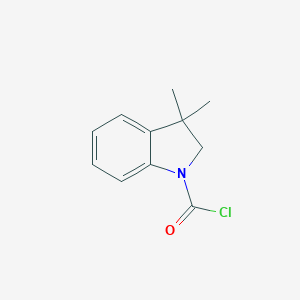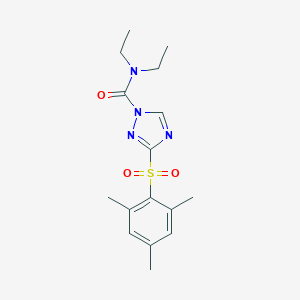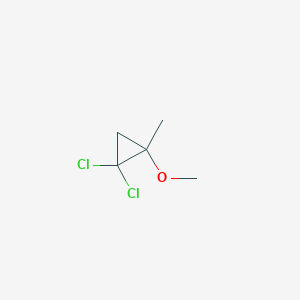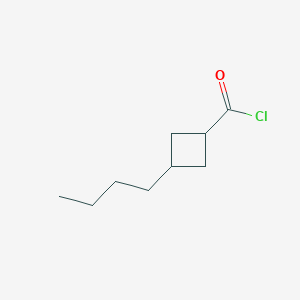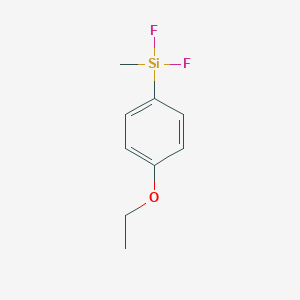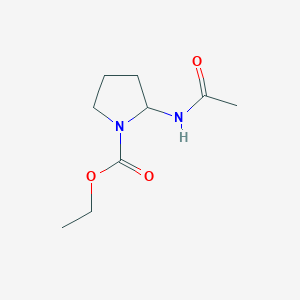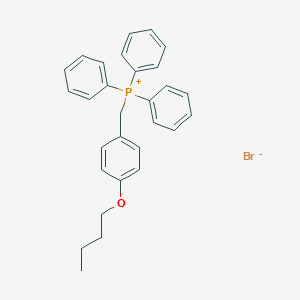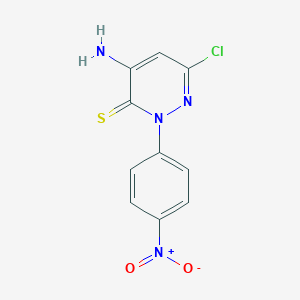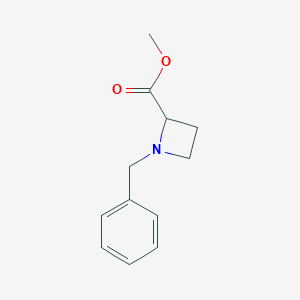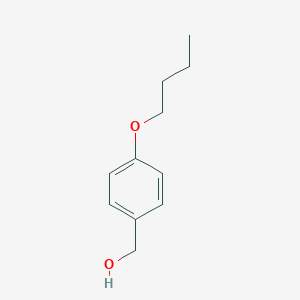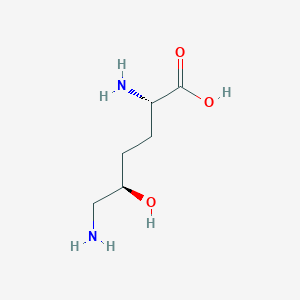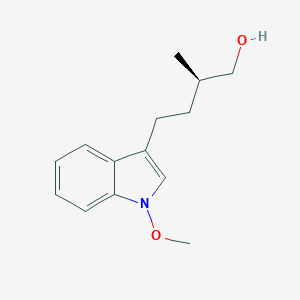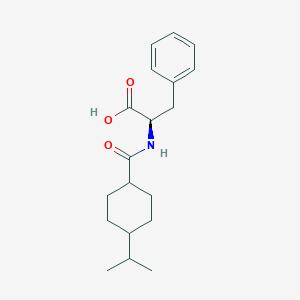
Nateglinide
Vue d'ensemble
Description
Nateglinide est un agent antihyperglycémique oral utilisé dans le traitement du diabète de type 2. Il appartient à la classe des méglitinides, des médicaments qui abaissent la glycémie. This compound a été développé par Ajinomoto, une société japonaise, et est commercialisé par Novartis sous le nom commercial de Starlix .
Mécanisme D'action
Target of Action
Nateglinide primarily targets the β cells of the pancreas . These cells play a crucial role in the regulation of blood glucose levels by secreting insulin, a hormone that promotes the uptake of glucose into cells .
Mode of Action
This compound interacts with its targets by binding to ATP-sensitive potassium channels in the membrane of the β cells . This binding action leads to the closure of these channels, causing the β cells to depolarize . The depolarization then opens voltage-gated calcium channels, leading to an influx of calcium ions . This calcium influx triggers the fusion of insulin-containing vesicles with the cell membrane, resulting in the secretion of insulin .
Biochemical Pathways
The primary biochemical pathway affected by this compound is the insulin secretion pathway . By stimulating the release of insulin, this compound helps lower blood glucose levels. It achieves this by modulating the activity of ATP-sensitive potassium channels and voltage-gated calcium channels in pancreatic β cells .
Pharmacokinetics
This compound exhibits rapid absorption from the gastrointestinal tract and undergoes extensive biotransformation in the liver to at least nine metabolites . The major metabolites are less active than the parent compound, with one minor metabolite, the isoprene, having the same potency . This compound is predominantly excreted in urine (83%) as metabolites, with only 16% of the dose excreted unchanged . Its elimination half-life is approximately 1.4 hours .
Result of Action
The molecular and cellular effects of this compound’s action primarily involve the stimulation of insulin secretion from the pancreas . This results in a decrease in postprandial (after meal) blood glucose levels . This compound induces an early insulin response to meals, which is crucial for maintaining glucose homeostasis .
Action Environment
The action, efficacy, and stability of this compound can be influenced by various environmental factors. Additionally, genetic polymorphisms in hepatic-uptake transporter SLCO1B1 (OATP1B1) and cytochrome P450 enzymes like CYP2C9 and CYP3A4, which are involved in this compound metabolism, can also influence its pharmacokinetics .
Applications De Recherche Scientifique
Nateglinide has several scientific research applications:
Medicine: this compound is primarily used in the treatment of type 2 diabetes mellitus. .
Pharmaceutical Research: This compound is used in the development of sustained-release formulations to improve its bioavailability and therapeutic efficacy.
Biological Studies: This compound is used in studies investigating the mechanisms of insulin secretion and glucose metabolism.
Industrial Applications: This compound is used in the formulation of fast-disintegrating tablets for improved patient compliance.
Analyse Biochimique
Biochemical Properties
Nateglinide plays a crucial role in biochemical reactions by interacting with specific enzymes and proteins. It primarily targets the ATP-sensitive potassium channels (K_ATP channels) on the pancreatic beta cells. By binding to these channels, this compound inhibits their activity, leading to cell membrane depolarization. This depolarization opens voltage-gated calcium channels, resulting in an influx of calcium ions. The increased intracellular calcium concentration triggers the exocytosis of insulin-containing vesicles, thereby increasing insulin secretion .
Cellular Effects
This compound influences various cellular processes, particularly in pancreatic beta cells. It enhances insulin secretion, which is crucial for glucose homeostasis. Additionally, this compound affects cell signaling pathways by modulating the activity of K_ATP channels and calcium channels. This modulation impacts gene expression related to insulin synthesis and secretion. In other cell types, this compound’s effects are less pronounced but may include alterations in cellular metabolism and signaling pathways .
Molecular Mechanism
At the molecular level, this compound exerts its effects by binding to the sulfonylurea receptor 1 (SUR1) subunit of the K_ATP channels on pancreatic beta cells. This binding inhibits the channel’s activity, leading to membrane depolarization and subsequent opening of voltage-gated calcium channels. The resulting calcium influx promotes insulin vesicle fusion with the cell membrane and insulin release. This compound’s rapid binding and dissociation from the SUR1 subunit contribute to its short duration of action .
Temporal Effects in Laboratory Settings
In laboratory settings, the effects of this compound have been observed to change over time. The compound is relatively stable under standard conditions but can degrade under extreme pH or temperature conditions. Long-term studies have shown that this compound maintains its efficacy in stimulating insulin secretion over extended periods, although its rapid onset and short duration of action mean that its effects are most pronounced shortly after administration .
Dosage Effects in Animal Models
In animal models, the effects of this compound vary with dosage. At therapeutic doses, this compound effectively lowers postprandial blood glucose levels without causing significant hypoglycemia. At higher doses, adverse effects such as hypoglycemia and potential toxicity have been observed. These effects highlight the importance of careful dosage management to maximize therapeutic benefits while minimizing risks .
Metabolic Pathways
This compound is metabolized primarily in the liver through the cytochrome P450 enzyme system, particularly CYP2C9 and CYP3A4. The major metabolites are less active than the parent compound and are excreted in urine and feces. This compound’s metabolism involves hydroxylation and subsequent conjugation reactions, which facilitate its elimination from the body .
Transport and Distribution
Within cells, this compound is transported and distributed through passive diffusion and active transport mechanisms. It binds to plasma proteins, which influences its distribution and bioavailability. This compound’s rapid absorption and distribution are critical for its quick onset of action, allowing it to effectively manage postprandial glucose levels .
Subcellular Localization
This compound’s subcellular localization is primarily within the cytoplasm of pancreatic beta cells, where it interacts with K_ATP channels on the cell membrane. This localization is essential for its role in modulating insulin secretion. This compound does not require specific targeting signals or post-translational modifications for its activity, as its effects are mediated through direct binding to its target channels .
Méthodes De Préparation
Nateglinide peut être synthétisé selon différentes méthodes. Une méthode courante implique la réaction de la D-phénylalanine avec l'acide trans-4-isopropylcyclohexanecarboxylique. La réaction est généralement effectuée en présence d'un agent de couplage tel que le dicyclohexylcarbodiimide (DCC) et d'un catalyseur tel que la 4-diméthylaminopyridine (DMAP) dans un solvant organique . Une autre méthode implique la préparation de microsphères d'éthylcellulose à libération prolongée chargées de this compound en utilisant une technique d'émulsification de solvant huile-dans-eau (H/E) .
Analyse Des Réactions Chimiques
Nateglinide subit diverses réactions chimiques, notamment :
Oxydation : this compound peut être oxydé pour former des métabolites hydroxy et glucuronide.
Réduction : Les réactions de réduction de this compound sont moins fréquentes mais peuvent se produire dans des conditions spécifiques.
Substitution : this compound peut subir des réactions de substitution, en particulier en présence de nucléophiles forts.
Hydrolyse : this compound peut être hydrolysé en ses acides aminés constitutifs en conditions acides ou basiques.
Applications de la recherche scientifique
This compound a plusieurs applications en recherche scientifique :
Médecine : this compound est principalement utilisé dans le traitement du diabète de type 2. .
Recherche pharmaceutique : This compound est utilisé dans le développement de formulations à libération prolongée pour améliorer sa biodisponibilité et son efficacité thérapeutique.
Études biologiques : This compound est utilisé dans des études qui examinent les mécanismes de la sécrétion d'insuline et du métabolisme du glucose.
Applications industrielles : This compound est utilisé dans la formulation de comprimés à désintégration rapide pour améliorer la conformité des patients.
Mécanisme d'action
This compound abaisse les taux de glucose sanguin en stimulant la libération d'insuline par le pancréas. Il y parvient en fermant les canaux potassiques dépendants de l'ATP dans la membrane des cellules bêta. Cela dépolarise les cellules bêta et provoque l'ouverture des canaux calciques dépendants du voltage. L'afflux de calcium résultant induit la fusion des vésicules contenant de l'insuline avec la membrane cellulaire, conduisant à la sécrétion d'insuline .
Comparaison Avec Des Composés Similaires
Nateglinide est souvent comparé à d'autres agents antihyperglycémiques, tels que la répaglinide et la metformine :
Répaglinide : this compound et répaglinide appartiennent tous deux à la classe des méglitinides et stimulent la sécrétion d'insuline.
Metformine : Contrairement à la this compound, la metformine améliore la sensibilité à l'insuline et réduit la production de glucose hépatique.
Sémiglutide : Le sémiglutide est un agoniste du récepteur du peptide-1 de type glucagon (GLP-1) qui abaisse les taux de glucose sanguin en stimulant la sécrétion d'insuline et en réduisant la sécrétion de glucagon.
Composés similaires
- Répaglinide
- Metformine
- Sémiglutide
L'apparition rapide et la courte durée d'action de la this compound la rendent unique parmi les agents antihyperglycémiques, offrant une approche ciblée de la gestion de l'hyperglycémie postprandiale .
Propriétés
IUPAC Name |
(2R)-3-phenyl-2-[(4-propan-2-ylcyclohexanecarbonyl)amino]propanoic acid | |
|---|---|---|
| Source | PubChem | |
| URL | https://pubchem.ncbi.nlm.nih.gov | |
| Description | Data deposited in or computed by PubChem | |
InChI |
InChI=1S/C19H27NO3/c1-13(2)15-8-10-16(11-9-15)18(21)20-17(19(22)23)12-14-6-4-3-5-7-14/h3-7,13,15-17H,8-12H2,1-2H3,(H,20,21)(H,22,23)/t15?,16?,17-/m1/s1 | |
| Source | PubChem | |
| URL | https://pubchem.ncbi.nlm.nih.gov | |
| Description | Data deposited in or computed by PubChem | |
InChI Key |
OELFLUMRDSZNSF-OFLPRAFFSA-N | |
| Source | PubChem | |
| URL | https://pubchem.ncbi.nlm.nih.gov | |
| Description | Data deposited in or computed by PubChem | |
Canonical SMILES |
CC(C)C1CCC(CC1)C(=O)NC(CC2=CC=CC=C2)C(=O)O | |
| Source | PubChem | |
| URL | https://pubchem.ncbi.nlm.nih.gov | |
| Description | Data deposited in or computed by PubChem | |
Isomeric SMILES |
CC(C)C1CCC(CC1)C(=O)N[C@H](CC2=CC=CC=C2)C(=O)O | |
| Source | PubChem | |
| URL | https://pubchem.ncbi.nlm.nih.gov | |
| Description | Data deposited in or computed by PubChem | |
Molecular Formula |
C19H27NO3 | |
| Source | PubChem | |
| URL | https://pubchem.ncbi.nlm.nih.gov | |
| Description | Data deposited in or computed by PubChem | |
DSSTOX Substance ID |
DTXSID9040687 | |
| Record name | Nateglinide | |
| Source | EPA DSSTox | |
| URL | https://comptox.epa.gov/dashboard/DTXSID9040687 | |
| Description | DSSTox provides a high quality public chemistry resource for supporting improved predictive toxicology. | |
Molecular Weight |
317.4 g/mol | |
| Source | PubChem | |
| URL | https://pubchem.ncbi.nlm.nih.gov | |
| Description | Data deposited in or computed by PubChem | |
Solubility |
Practically insoluble | |
| Record name | Nateglinide | |
| Source | DrugBank | |
| URL | https://www.drugbank.ca/drugs/DB00731 | |
| Description | The DrugBank database is a unique bioinformatics and cheminformatics resource that combines detailed drug (i.e. chemical, pharmacological and pharmaceutical) data with comprehensive drug target (i.e. sequence, structure, and pathway) information. | |
| Explanation | Creative Common's Attribution-NonCommercial 4.0 International License (http://creativecommons.org/licenses/by-nc/4.0/legalcode) | |
Mechanism of Action |
Nateglinide activity is dependent on the presence functioning β cells and glucose. In contrast to sulfonylurea insulin secretatogogues, nateglinide has no effect on insulin release in the absence of glucose. Rather, it potentiates the effect of extracellular glucose on ATP-sensitive potassium channel and has little effect on insulin levels between meals and overnight. As such, nateglinide is more effective at reducing postprandial blood glucose levels than fasting blood glucose levels and requires a longer duration of therapy (approximately one month) before decreases in fasting blood glucose are observed. The insulinotropic effects of nateglinide are highest at intermediate glucose levels (3 to 10 mmol/L) and it does not increase insulin release already stimulated by high glucose concentrations (greater than 15 mmol/L). Nateglinide appears to be selective for pancreatic β cells and does not appear to affect skeletal or cardiac muscle or thyroid tissue. | |
| Record name | Nateglinide | |
| Source | DrugBank | |
| URL | https://www.drugbank.ca/drugs/DB00731 | |
| Description | The DrugBank database is a unique bioinformatics and cheminformatics resource that combines detailed drug (i.e. chemical, pharmacological and pharmaceutical) data with comprehensive drug target (i.e. sequence, structure, and pathway) information. | |
| Explanation | Creative Common's Attribution-NonCommercial 4.0 International License (http://creativecommons.org/licenses/by-nc/4.0/legalcode) | |
CAS No. |
105816-04-4, 105816-06-6 | |
| Record name | Nateglinide [USAN:USP:INN:BAN] | |
| Source | ChemIDplus | |
| URL | https://pubchem.ncbi.nlm.nih.gov/substance/?source=chemidplus&sourceid=0105816044 | |
| Description | ChemIDplus is a free, web search system that provides access to the structure and nomenclature authority files used for the identification of chemical substances cited in National Library of Medicine (NLM) databases, including the TOXNET system. | |
| Record name | N-((cis-4-(1-Methylethyl)cyclohexyl)carbonyl)-D-phenylalanine | |
| Source | ChemIDplus | |
| URL | https://pubchem.ncbi.nlm.nih.gov/substance/?source=chemidplus&sourceid=0105816066 | |
| Description | ChemIDplus is a free, web search system that provides access to the structure and nomenclature authority files used for the identification of chemical substances cited in National Library of Medicine (NLM) databases, including the TOXNET system. | |
| Record name | Nateglinide | |
| Source | DrugBank | |
| URL | https://www.drugbank.ca/drugs/DB00731 | |
| Description | The DrugBank database is a unique bioinformatics and cheminformatics resource that combines detailed drug (i.e. chemical, pharmacological and pharmaceutical) data with comprehensive drug target (i.e. sequence, structure, and pathway) information. | |
| Explanation | Creative Common's Attribution-NonCommercial 4.0 International License (http://creativecommons.org/licenses/by-nc/4.0/legalcode) | |
| Record name | Nateglinide | |
| Source | EPA DSSTox | |
| URL | https://comptox.epa.gov/dashboard/DTXSID9040687 | |
| Description | DSSTox provides a high quality public chemistry resource for supporting improved predictive toxicology. | |
| Record name | NATEGLINIDE | |
| Source | FDA Global Substance Registration System (GSRS) | |
| URL | https://gsrs.ncats.nih.gov/ginas/app/beta/substances/41X3PWK4O2 | |
| Description | The FDA Global Substance Registration System (GSRS) enables the efficient and accurate exchange of information on what substances are in regulated products. Instead of relying on names, which vary across regulatory domains, countries, and regions, the GSRS knowledge base makes it possible for substances to be defined by standardized, scientific descriptions. | |
| Explanation | Unless otherwise noted, the contents of the FDA website (www.fda.gov), both text and graphics, are not copyrighted. They are in the public domain and may be republished, reprinted and otherwise used freely by anyone without the need to obtain permission from FDA. Credit to the U.S. Food and Drug Administration as the source is appreciated but not required. | |
| Record name | N-((CIS-4-(1-METHYLETHYL)CYCLOHEXYL)CARBONYL)-D-PHENYLALANINE | |
| Source | FDA Global Substance Registration System (GSRS) | |
| URL | https://gsrs.ncats.nih.gov/ginas/app/beta/substances/XTM4DQP5S5 | |
| Description | The FDA Global Substance Registration System (GSRS) enables the efficient and accurate exchange of information on what substances are in regulated products. Instead of relying on names, which vary across regulatory domains, countries, and regions, the GSRS knowledge base makes it possible for substances to be defined by standardized, scientific descriptions. | |
| Explanation | Unless otherwise noted, the contents of the FDA website (www.fda.gov), both text and graphics, are not copyrighted. They are in the public domain and may be republished, reprinted and otherwise used freely by anyone without the need to obtain permission from FDA. Credit to the U.S. Food and Drug Administration as the source is appreciated but not required. | |
Retrosynthesis Analysis
AI-Powered Synthesis Planning: Our tool employs the Template_relevance Pistachio, Template_relevance Bkms_metabolic, Template_relevance Pistachio_ringbreaker, Template_relevance Reaxys, Template_relevance Reaxys_biocatalysis model, leveraging a vast database of chemical reactions to predict feasible synthetic routes.
One-Step Synthesis Focus: Specifically designed for one-step synthesis, it provides concise and direct routes for your target compounds, streamlining the synthesis process.
Accurate Predictions: Utilizing the extensive PISTACHIO, BKMS_METABOLIC, PISTACHIO_RINGBREAKER, REAXYS, REAXYS_BIOCATALYSIS database, our tool offers high-accuracy predictions, reflecting the latest in chemical research and data.
Strategy Settings
| Precursor scoring | Relevance Heuristic |
|---|---|
| Min. plausibility | 0.01 |
| Model | Template_relevance |
| Template Set | Pistachio/Bkms_metabolic/Pistachio_ringbreaker/Reaxys/Reaxys_biocatalysis |
| Top-N result to add to graph | 6 |
Feasible Synthetic Routes
Avertissement et informations sur les produits de recherche in vitro
Veuillez noter que tous les articles et informations sur les produits présentés sur BenchChem sont destinés uniquement à des fins informatives. Les produits disponibles à l'achat sur BenchChem sont spécifiquement conçus pour des études in vitro, qui sont réalisées en dehors des organismes vivants. Les études in vitro, dérivées du terme latin "in verre", impliquent des expériences réalisées dans des environnements de laboratoire contrôlés à l'aide de cellules ou de tissus. Il est important de noter que ces produits ne sont pas classés comme médicaments et n'ont pas reçu l'approbation de la FDA pour la prévention, le traitement ou la guérison de toute condition médicale, affection ou maladie. Nous devons souligner que toute forme d'introduction corporelle de ces produits chez les humains ou les animaux est strictement interdite par la loi. Il est essentiel de respecter ces directives pour assurer la conformité aux normes légales et éthiques en matière de recherche et d'expérimentation.



